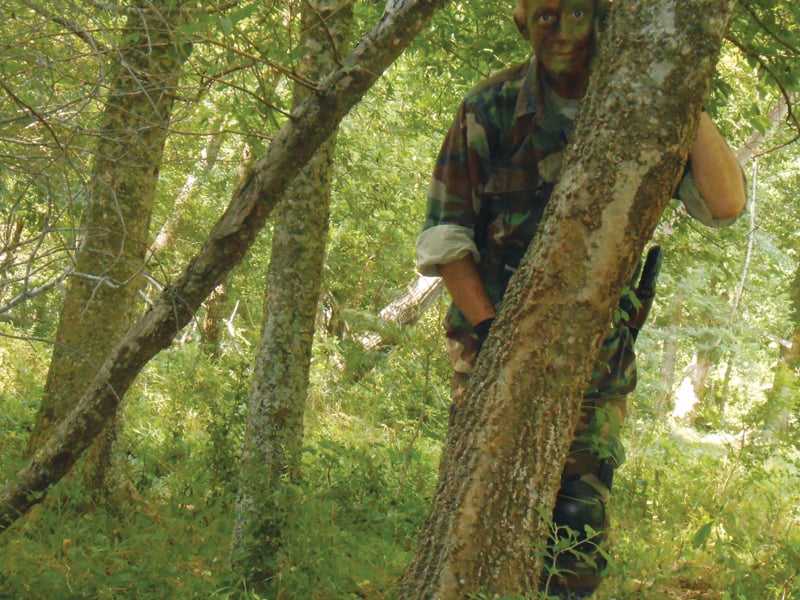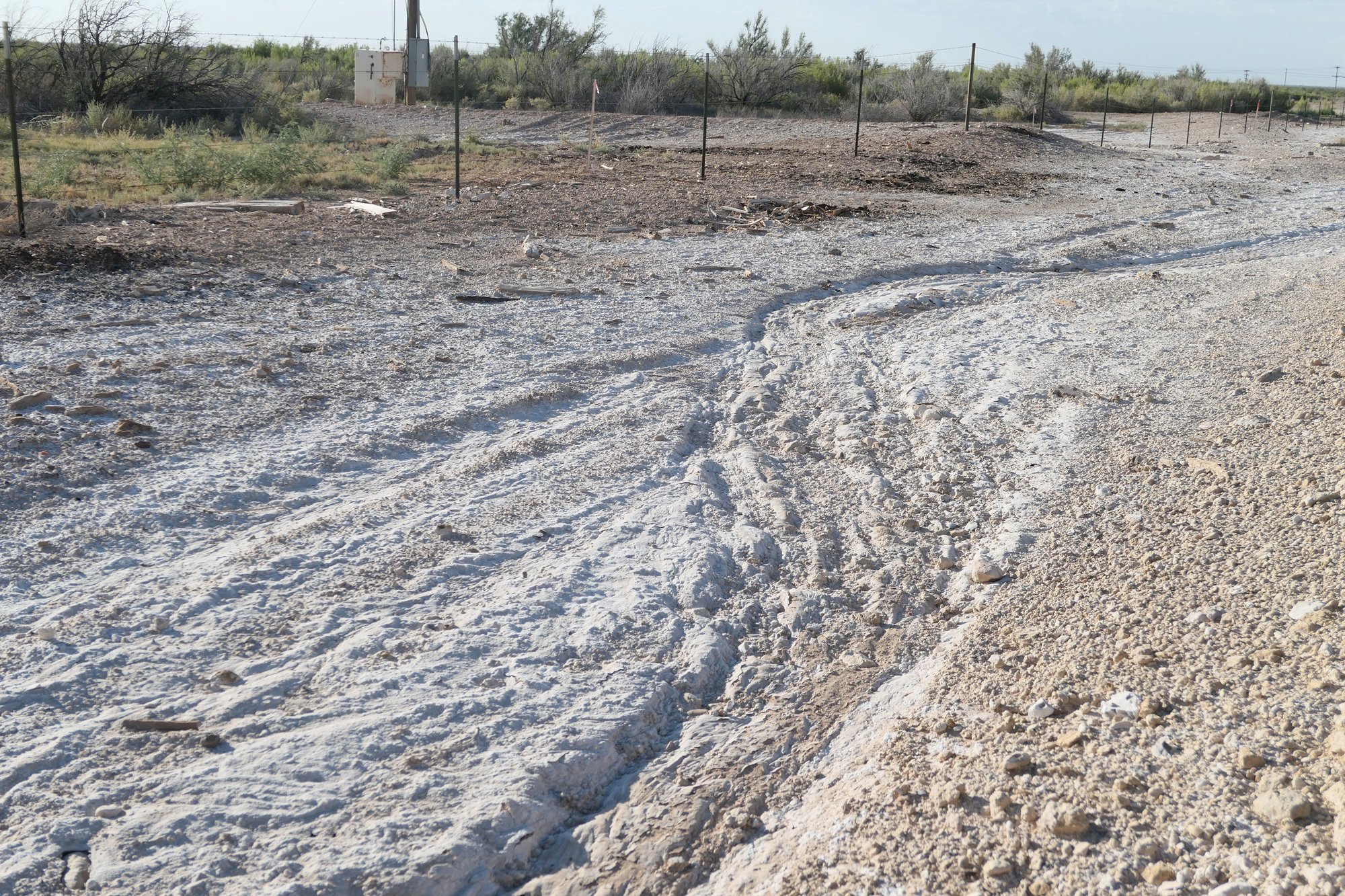
How the Law Finally Caught Up with East Texas ‘Survivalist’ Jeff Holliman

By the time Jeffrey Holliman was finally captured in August 2013 at his remote campsite in the dense woods of Nacogdoches County, he’d been living out there for nearly a year, traveling by night, raiding empty homes and abandoned trailers for money, guns and provisions, making only limited contact with the people who’d once been his neighbors in the town of Melrose.
The Observer recounted Holliman’s time in the woods and the town’s struggle to identify its tormentor in our February 2014 issue. Holliman, Nacogdoches County Sheriff Jason Bridges, and folks in town pieced together much of the story, but questions lingered about the circumstances that brought Holliman’s time in the woods to an end.
Holliman said he’d considered fleeing the state, but ultimately decided—for reasons he wouldn’t reveal—that he was ready to give up the hermit life and answer to the law. Bridges said Holliman had been found at his camp, but was so dehydrated and sick from drinking tainted pond water that he couldn’t have put up much of a fight regardless. Bridges didn’t witness the capture, and the two men who made the arrest, Nacogdoches County Precinct 4 Constable David Stone and a deputy, wouldn’t discuss it until after Holliman’s criminal case had concluded.
On Monday, Stone emailed to say that he was ready to tell the story.

In the months that Holliman was living in the woods, the run of burglaries in Melrose had become a source of embarrassment for local law enforcement. Bridges had repeatedly sent deputies to interview victims and watch the county roads at night, to no avail. Stone, who lives in Melrose and knew Holliman from town, would venture into the woods on horseback or four-wheeler, patrolling through the night in shifts along with his deputies Justin Murray and Shawn Murray (no relation). “We never quit,” Stone says. “We looked every day.”
Shawn Murray accompanied Stone on the night of Aug. 2 to check out a trail a property owner had discovered on his land. They’d arranged to meet the landowner at 11, but at 10:30 Stone got a call from Murray, who’d gone out early. “You could hear the excitement in his voice,” Stone recalls. “He said, ‘I think I found his tent.’”
They drove out to the property, and Stone and Murray followed a well-worn trail until a fainter one, no more discernable than a deer trail, branched off. Stone guesses they followed that one three-quarters of a mile, though in the dense forest it felt like much farther. At last, Stone says, they reached an orange tent. Stone and Murray yelled to announce their presence, told Holliman to come out with his hands up, and heard nothing. Murray found the tent zipper and, bracing himself for confrontation, opened the door to find… another zipper. “That really got your heart going,” Stone says. “You hate not knowing the unknown.”
He undid the inner zipper as well, and found only weapons and supplies, he says. There was no sign of Holliman. It was a big break in the case, Stone figured, but also another night of fruitless searching for the man. Then Murray whispered that he’d found another trail, and led the way down the path, which forced the men into a narrow tunnel cut through the underbrush. At the far end, Stone could see a camouflage cargo net. Ducking through the thicket, Stone told Murray to watch out for traps. Then, from up ahead, came a noise—maybe a cough, Stone recalls—and the two flipped on their flashlights, sprinted forward and split up to get around the net, Murray to the right and Stone to the left.
On the other side, Stone faced another tent, this one with its door open but its mosquito mesh still zipped. Shining his light through the scrim, Stone found himself face-to-face with Holliman, who held a knife in one hand, with a pistol on the plastic tub beside him.
“You could see his knuckles get white, he was grippin’ that knife real tight,” Stone says. “The look in his eyes, he was thinking, ‘Do I want to die here tonight or do I want to try it?’”
Stone says he and Murray yelled at Holliman to drop the knife. After a long moment, Murray broke the standstill by starting to cut through a side of the tent. Holliman heard the noise and turned, Stone says, and Murray tackled him. At that point, Holliman’s dehydration seemed to take hold and his strength gave out and the teo men carried Holliman out of the woods.
Holliman, who hasn’t been free since that night, was indicted on 13 burglary charges, plus seven more for being a felon in possession of guns and a silencer.
Holliman, who hasn’t been free since that night, was indicted on 13 burglary charges, plus seven more for being a felon in possession of guns and a silencer. His trial began this month in Nacogdoches, but on Monday Holliman cut it short, accepting a plea deal and a 25-year prison sentence.
In the run-up to the trial, Holliman’s lawyer, John Boundy, got to see the wealth of evidence that investigators had amassed: 43 discs containing documents, photos and video, with interviews of burglary victims and conversations with Holliman. Boundy recalled one three-and-a-half-hour video in which Holliman explained the “metaphysical spirituality” he developed during his time alone, and the alter ego named Seth who guided his journey—likely inspired by the new-age author Jane Roberts’ Seth Material, some volumes of which were found in Holliman’s camp.
Key to the defense Boundy had planned was a series of photographs of Holliman on the floor in a trailer he was accused of robbing. Each photo features a different assortment of guns and outdoor gear, but Holliman, who is apparently asleep in the photos, never moves. “The camera angle, the distance from the camera to the subject and the location of the property around him—all of those change,” Boundy says. “The only thing that’s the same is that he’s comatose or unconscious in that unnatural position.” Boundy’s conclusion: Somebody else took the photos.
His defense cast Holliman as a forest-dwelling protector of the town, up against people far more dangerous than himself, one of whom had invited Holliman into the trailer. Boundy says a recent raid on a hidden marijuana farm in the county, and other illicit growers still on the loose, figured into the questions he addressed to witnesses.
“My theory was, yeah, maybe my guy was a ghost in the woods, but there’s other ghosts worse than him,” Boundy says.
Selling that story posed challenges. Boundy compares it to the scene from The Terminator in which Kyle Reese struggles to convince Los Angeles cops of his mission from the future. “The story he tells is so perfect because there’s not a shred of physical evidence because of the nature of the story.”
Holliman was in the midst of his trial on Monday when he accepted a plea deal. He pleaded guilty to a single burglary charge and was sentenced to 25 years in prison. Boundy says Holliman could be eligible for early release after five years.
Among all the evidence gathered on Holliman during months of investigation, there’s still no sign of the money and jewelry that disappeared from homes in Melrose two years ago. If it’s hidden or buried, Constable Stone figures it’ll stay that way for a long time.
But what haunts Stone about the case is the empty tent he and Murray found the night they captured Holliman. Looking back, he realizes how exposed he and Murray had been, how easily, in the dark, on Holliman’s turf, the tables could’ve turned. “He could’ve very, very easily come out of the tunnel on us,” Stone says. “The whole time he was behind us, and we didn’t know.”


